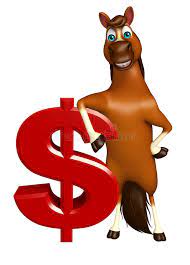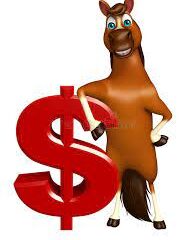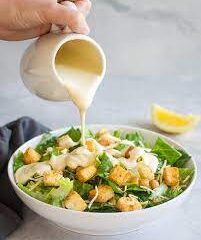Trimming Your Horse Feed Budget

This article is long overdue as the cost of horse feed and supplements has been rising for some time. This has become a frequent topic of conversation lately as these cost increases don’t seem to be easing anytime soon.
There are several ways to cut some corners on your feed budget without sacrificing the health and performance of your horse.
Before we dive in I’d like to point out that there are two types of horse keeper out there and each has a different set of considerations when making these choices; the individual horse keeper and the commercial operator.
Obviously feeding your own horses is different than feeding a barn full of boarders and training horses when it comes to making budget and performance decisions for those horses.
There’s one common element in either case and that is in order to reduce cost you have to give something up in return. Simply switching from a $30 feed to a $25 feed isn’t telling the whole savings story. Something is missing in that $25 feed and it will show up in your horse…maybe.
Private Barn/Owners
This section will be if you are making the feed decisions for your own horses whether they are in your backyard or not you are purchasing feed and supplements for your horses.
First, Evaluate Your Supplements
What troubles me most as a nutrition specialist are all the owners spending billions of hard earned dollars on useless and sometimes dangerous supplements. It sends me over the edge when owners come to me about switching feeds but refuse to dump their supplements.
This is italicized because it’s significant:
Your nutrition money should be invested in high quality feed and forage before you spend a penny on nutritional supplements.
Saving $25 a month by switching to a value feed while continuing to dump $50 a month in joint supplements that either don’t work or aren’t really necessary is just bad economics.
Unless a supplement has been advised by a veterinarian or nutrition specialist to address a specific lack in a horse’s diet stop using it.
My horses are on Vitamin E because the forage and pastures I have are deficient. I have one horse on a very expensive Omega fatty acid supplement because it has significantly helped with her stocking up. My other three horses have no need of this oil so they don’t get it. At $149 a gallon I may discontinue it until things get a little better. I have another horse on Outlast gut supplement because without it her fecal water syndrome returns.
If you’re feeding random supplements there’s not a doubt in my mind that you will save anywhere from $30 to $50 per month per horse by discontinuing them and you’re not going to notice a difference in the horse unless the supplement is being given to address a present condition.
There is no data to support turmeric or aloe or colic prevention or devil’s claw or yucca or pixie dust as effective in horses. Drop them all and save some money.
Hoof supplements are expensive but I can tell you from extensive experience they simply aren’t needed if your horses are on a high quality supplemental feed or ration balancer.
While we’re on the subject many supplements are horribly overpriced. If you have a horse on magnesium for calming you can go to a feed store or online and buy livestock grade magnesium oxide for around $1 a pound. The same thing goes for biotin. Dairy farmers feed biotin to their cows to help their hooves.
Vitamin E needs to be pure and natural to be more effective so saving money on livestock grade E isn’t a good choice.
I would say the same for performance supplements even if they DO work. If budget is tight chances are you aren’t showing or training as hard so discontinue that expensive amino acid supplement.
Here’s something else to think about. If you discontinue a supplement and see some adverse results you can always put it back in.
Take a Big Picture View When Considering a Feed Change
You have four horses in your barn at home and they each average five pounds of feed per day so you are buying 12 bags of feed per month. If you are able to save $3 per bag that’s $36 per month. It may not sound like much but with rising gas, oil, grocery and electricity bills it all adds up so let’s take a look at making the change.
What are You Giving Up?
As I mentioned earlier, horse feed is a competitive business so when a company rep claims that their feed is exactly the same as the other guy’s but we don’t spend money on advertising and fancy bags just run away. Feel free to laugh in their face first if you so desire but run. It’s a lie. I’ve done the math hundreds of times for clients. Virtually all horse feed is the same cost when you factor in calories and ingredients.
If you are moving to a lower cost feed you are sacrificing something. The question becomes how important is that something to your horse.
Let’s use an example from a lie I’m very familiar with, Nutrena/Cargill. ProForce Fuel is an excellent feed for moderate to high performance horses. This feed also does a good job for some lazy backyard horses. Currently this feed is about $28 a bag.
Cargill makes the Triumph line of feeds. One Triumph feed I really like is Fiber Plus. Fiber Plus is basically ProForce Fuel without the fortification. FP is beet pulp based with a very reasonable NSC level and a nice fat source. FP doesn’t have nearly the amino acid package that’s in ProForce Fuel. Fiber Plus averages around $20 a bag.
Some of the “somethings” you’ll be giving up by switching are:
Fiber Plus is a dealer only product so it can be difficult to find and you may have to travel a distance to find it.
Your horses will maintain weight on Fiber Plus but their topline will suffer and if they are in heavy work you will see a difference in endurance and recovery.
This is the same trade off to consider when switching to any lower cost feed. Performance and condition. This may not be a problem if you are also economizing on showing or training.
From an economics standpoint there is no way changing to an economy feed and making up the fortification with supplements will make any budgetary sense. In some cases you may spend more.
You Can’t Make Your Own Feed
If you’re thinking that you are going to save money and get a better product by replacing a high quality feed with forage pellets, soy bean meal and powdered supplements please think again.
Just from a cost standpoint when you run the numbers after adding up all the ingredients your savings will be minimal if there even are any.
Then there’s the convenience factor. Are you really going to want to stir up four different buckets twice a day?
The majority of forage products aren’t tested for quality or nutrient values so you really don’t know what you’re getting in the bag. Even if you did you’re probably not as smart as the experienced equine PhDs who designed the feed you are trying to replace.
The Bottom Line on Changing Feeds to Save Money
If you want to try a more economical feed for your horse here are some guidelines to follow:
Don’t give up too much. Find a good value feed that offers guaranteed moderate NSC at less than 20%. If you go with a feed that is high in NSC because corn is still the cheapest ingredient you are going to pay in the long run with health problems.
If performance and condition are important don’t change your feed. You’ll be adding supplements back in and you’ll be spending as much if not more in the long run.
Commercial Barn Operators
Boarding Facilities
You have a barn full of other people’s horses and you have a fixed budget on your expenses in order to remain profitable. Everything is going up, hay, power, fuel for the tractor and the truck, etc. Feed choice is something you have some control over.
This is the time to have a conversation with the boarders. Everything is going up for them as well but it’s an important conversation to have because if you close your doors they have no place to keep their horses.
If you start feeding a lower quality feed then it will be on the boarders to decide what supplements they would like to provide for their horse. There may be a significant gap in boarder’s goals. One may have a 20 year old retired mare who may not care that the topline drops a tad. Another may have a seven year old OTTB in hunter training. The point is that the boarders understand that they now bear more responsibility for the performance and condition of their horses.
As someone with many years of business management experience my advice is to call a boarder’s meeting and review the numbers and options before asking them to help with the decision.
“So as you all know the cost of everything is increasing so I’m forced to pass these increases along to you so that the facility survives,” is a perfectly appropriate conversation to have.
If a boarder leaves because your competition is holding their board rates it’s better for your competition to close than you.
Training and Competition Barn
Your horses are an investment in your business. They are your primary “equipment” for carrying your students and winning shows. If your equipment isn’t maintained well it will ultimately impact your revenue.
I have done evaluations for dozens of performance barns and the result is always the same; Feed the best possible feed available and you’ll save money in both the short and the long run.
I’ll use my favorite example.
A friend of mine has a very lovely dressage/hunter training and breeding barn with about 40 horses. She called me in to do a review on her feed program because she felt she was losing control and spending too much money.
I started with a Body Condition Score evaluation on every horse on the property and they all looked great. Whatever the feed program was, it was working so…?
The feed program was a mixture of high quality feeds, just not the right ones.
Half Purina Senior Active for calorie density and cool energy. Half Purina Impact Professional Performance to save a few dollars while offering a bit more energy.
This mix was then topped with Enrich ration balancer for topline, Purina SuperSport for advanced amino acid support and Purina Amplify for additional calories for the pregnant and lactating mares. Everybody was on Outlast for gut support.
As I just mentioned the horses were in great shape so from a nutrition standpoint the program was working.
However, as in any large barn there was staff turn over and time constraints that made a fussy program challenging to execute.
The solution was simple. We dropped everything and put the majority of the herd on Purina Ultium Gastric Care which offered the calorie density of Senior Active, the energy of Professional Performance, the high fat of the Amplify and the amino acid package in SuperSport.
The pregnant mares and weanlings went on Ultium Growth.
The horses still looked great and the feed budget dropped by nearly $1,000 per month. Not a typo, one….thousand…dollars per month.
The added bonus was a program much more easily managed.
Here’s a personal plug for independent nutrition consultants.
This feed program was designed by a Purina Feed Specialist. He didn’t do a bad job because the horses were in great shape but his motivation wasn’t the best interest of the customer. The feed revenue dropped significantly and I have no doubt it had an impact on both the Purina rep and the Purina dealer.
I have no doubt because within twelve hours I had a heated conversation with both of those parties wanting to know just what the hell I was doing.
I ended the conversation abruptly by letting them know that had I been working on behalf of a competitive dealer and feed company they would have lost 100% of the sales to that barn because I would have taken it away.
Anyway, my point is that if you are running a competitive training, breeding and competition operation drop most of your performance supplements, reevaluate your base feed program and transition to the appropriate high quality feeds to achieve your goals.


